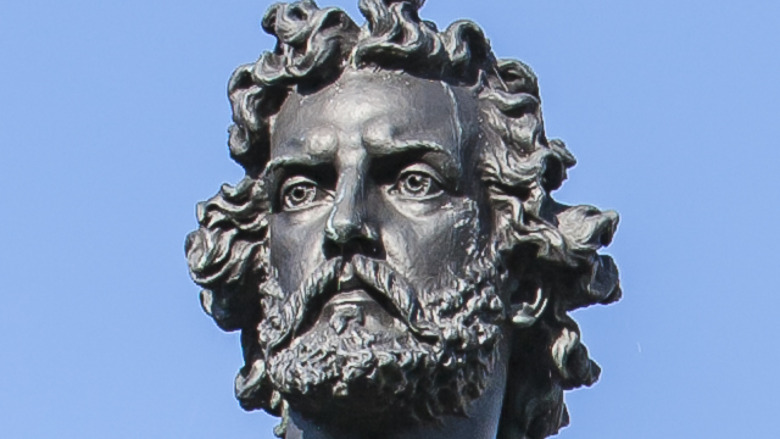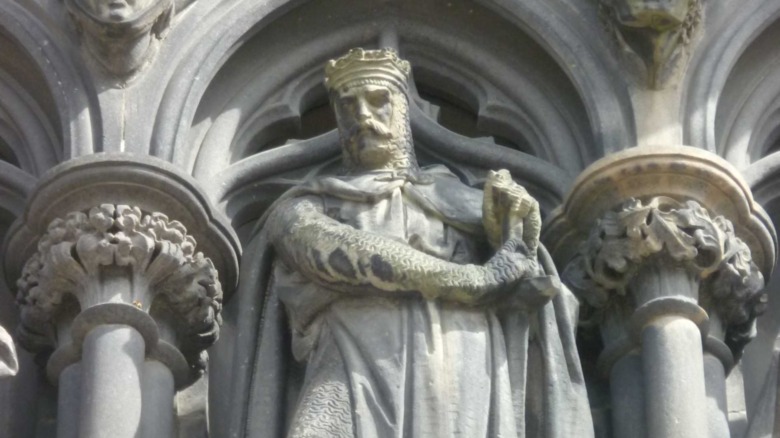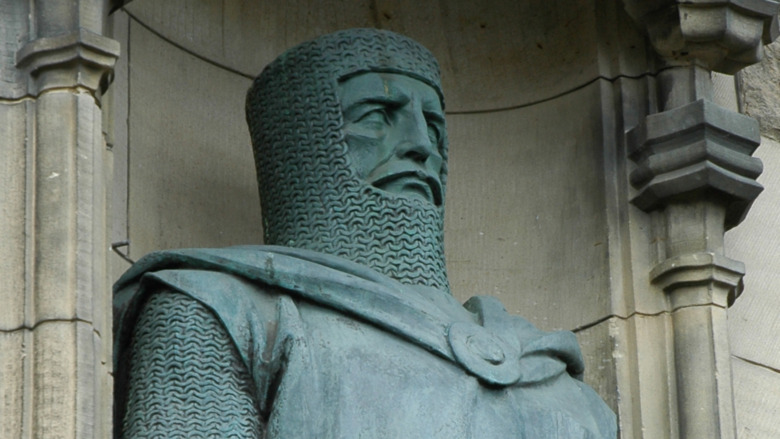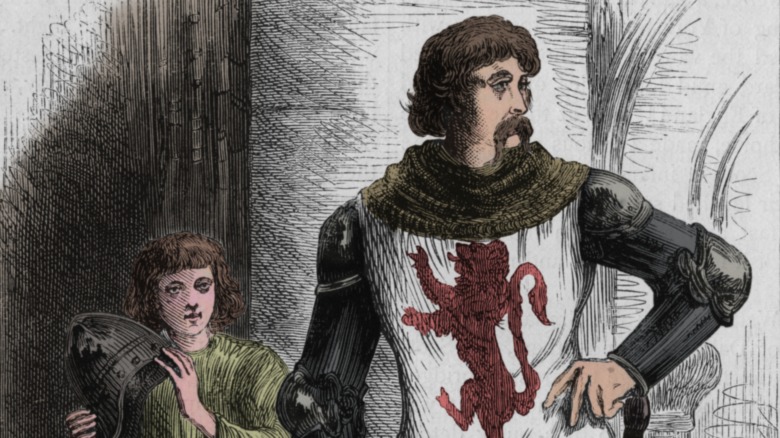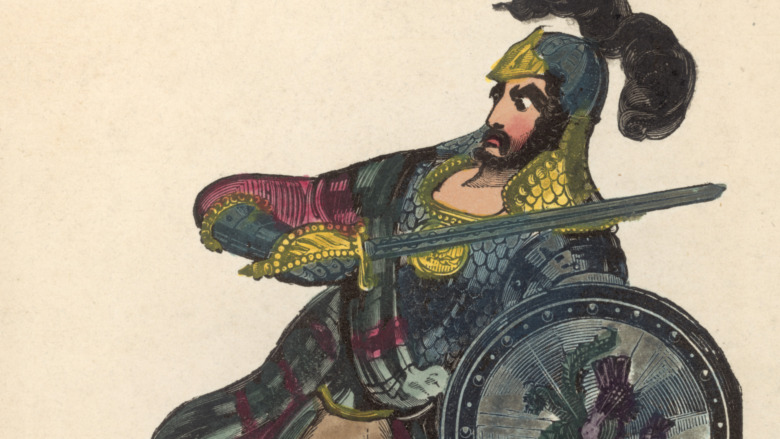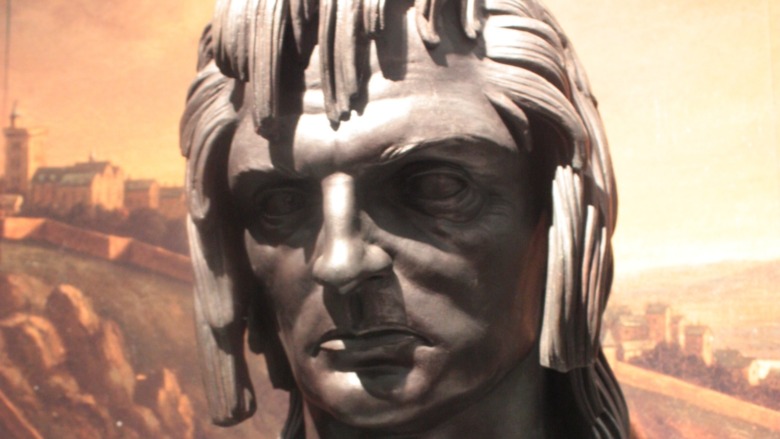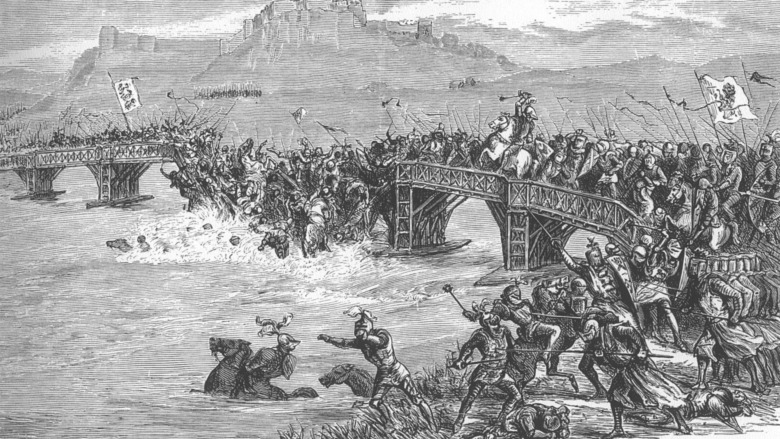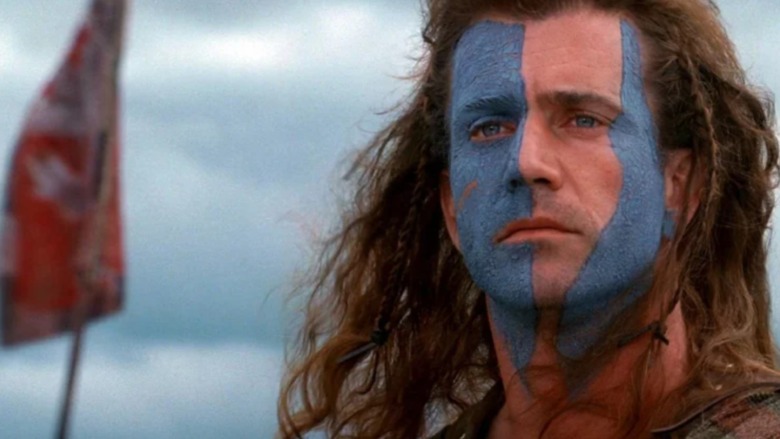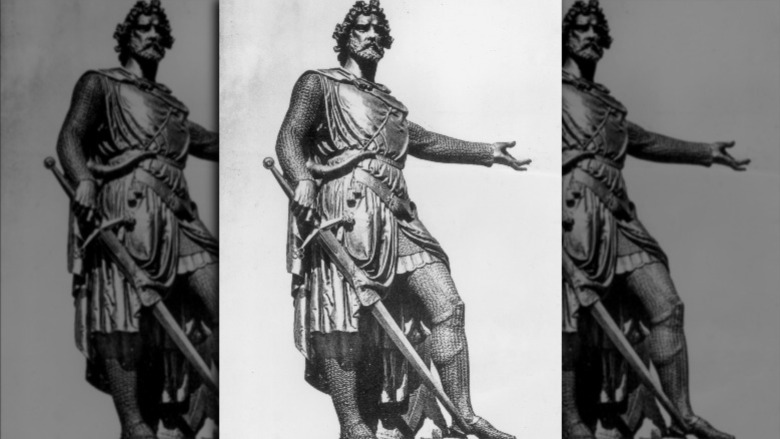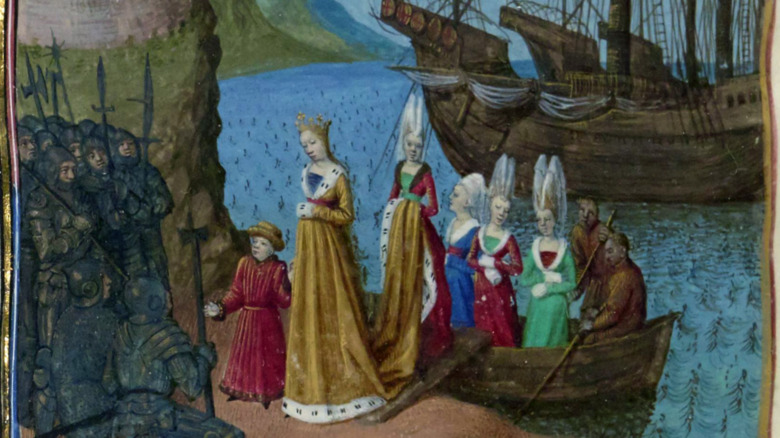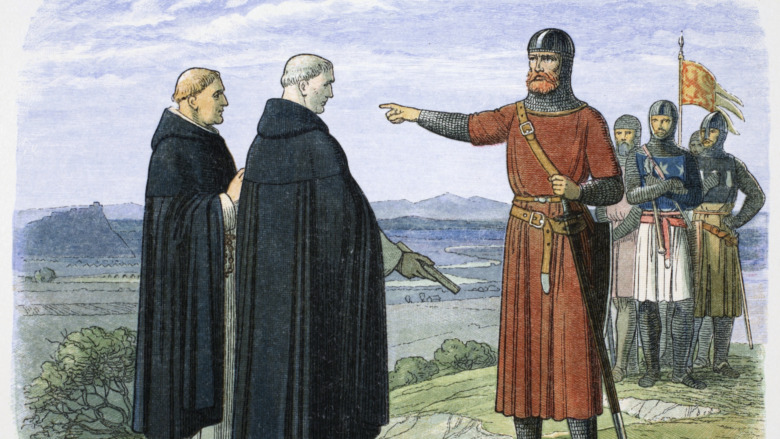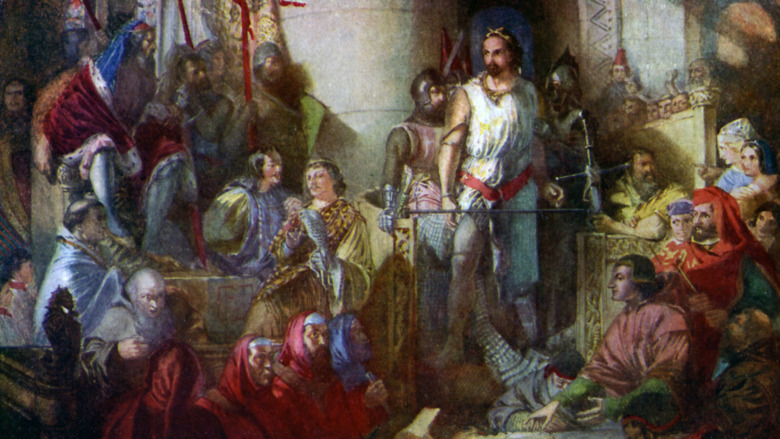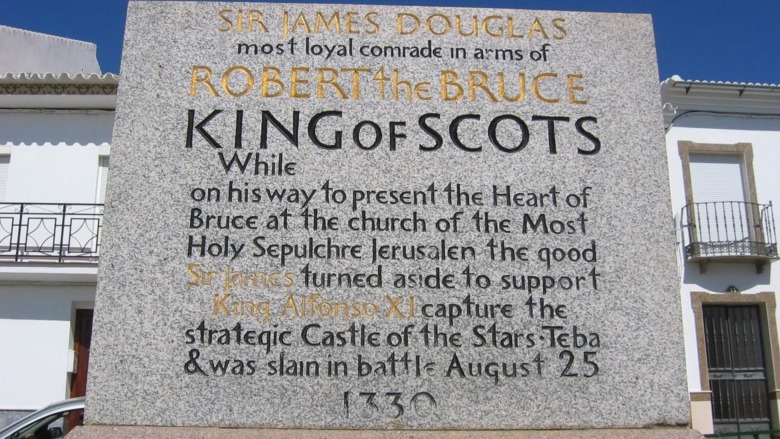False Things You Believe About William Wallace
It is difficult to deny that "Braveheart" is an absolute classic. With five Academy Awards, including Best Picture and Best Director, the film was a huge success among both critics and fans. And even to this day, more than 25 years after its release, the film is still loved by my many around the world. As an episode of "South Park" said so bluntly yet correctly, "Say what you want about Mel Gibson, but the son of a b**** knows story structure."
As one of Gibson's best films, this is certainly true with "Braveheart," which enthralled audiences with a heartbreaking tale of love and courage amid brutal action scenes that left viewers on the edge of their seats. Yet praise for the filmmaker should end there, because Gibson's goal was to simply tell his version of the story in the most entertaining way possible. So, like most Hollywood productions, the history was completely butchered.
The immense popularity of "Braveheart" has left millions of viewers with a warped understanding of William Wallace. The basic outline of the movie was true enough: Wallace did kick off the rebellion by killing a sheriff, and he crushed the English at Stirling, lost at Falkirk, and was later captured by the English and then executed. However, the movie has also done a great job of reinforcing popular fictions, rather than what is really known about the man.
Myth: Scotland was dominated by England in Wallace's youth
Those only slightly familiar with the story of William Wallace might think that the Scottish people had been oppressed by the English for as long as he was alive, but this was not so. The future rebel was born around 1270, while Scotland was going through a period of peace and stability. King Alexander III was a successful ruler who had not only managed to take back the Western Isles that were seized by Norway but then secured a strong alliance with the Norwegian king by arranging the marriage to his daughter in 1281, according to World History Encyclopedia.
Wallace's youth was a time of prosperity for Scotland in which the kingdom was on good terms with Norway, France, and the rest of Europe, even England. This was until a series of tragic events spelled disaster for the throne and the kingdom as a whole. When Alexander died without children in 1286, the throne passed to his granddaughter, Margaret, who also perished as well while on the voyage from Norway to Scotland in 1290. With no heirs to the Scottish throne left alive, that is when the English king got involved and tried to take over.
So, William Wallace was in his twenties and not a kid when everything went south for Scotland. Nor were his father and brother murdered by the English in his childhood, as shown in "Braveheart." Instead, it was the later events after 1292 that truly sparked Wallace's hatred of the English.
Myth: William Wallace was a commoner
William Wallace has frequently been portrayed as a man of the people going all the way back to the late Middle Ages. On the contrary, he was not a commoner and instead was a member of the lesser nobility. Although it was a minor and obscure aristocratic family, the Wallaces were certainly still nobles, says Chris Brown in his book, "William Wallace: The Man and the Myth."
Wallace's origin as the son of landowning knight has often been ignored by both the English and Scottish over the centuries for different reasons. To the Scots, it was then easier for him to be seen as a hero of the common people. On the other hand, his perceived lower status also made it easier for the English to vilify him. For this reason, the English also preferred the tales of Wallace's thievery or his acts as an outlaw.
Myth: The Wallace family had Scottish origins
There is no doubt that the Wallace family had been in Scotland for well over 100 years by the time of William's birth. However, the meaning of the surname may be a clue that the family originally came from Wales. According to A.F. Murison in his book, "William Wallace: Guardian of Scotland," the family was often referred to as "le Waleys," and it was written about in medieval records as if it was not a surname but rather a description of the family, as if they were saying "the Welsh of Elderslie."
On the other hand, there were also Wallaces in the army that invaded England during the Norman conquest. But regardless of whether the Wallaces were originally Norman, Welsh, or from somewhere else, William Wallace was thoroughly Scottish. He and his family were only minor landowners, so they had much closer ties to the common people of Scotland rather than to any prestigious baron who tried to still preserve the old Norman culture.
Myth: Wallace never fought for England
Stirling Bridge is the first battle that we know for certain that William Wallace fought in. But with that said, it is also very likely that he had at least some prior experience in warfare, given his success. However, it has been difficult for historians to determine where that might have been because no evidence of this possible military experience has been uncovered so far. One would think that his fierce opposition to the English would mean that he never would have fought for them, but that may not be true.
It is quite possible that Wallace fought as a mercenary in the English army as a young adult. Chris Brown admits that the Welsh wars of English king Edward I could have been where he began his military career, but the problem with that theory is that if it were true, the English would probably have realized that and used it against him. It would have discredited Wallace and put his loyalty into question for his fellow Scots if he had previously fought for the enemy.
Another possibility is that Wallace fought in the retinue of a Scottish noble. But if this were the case, he would not have seen major action because Scotland had not engaged in any national war throughout his youth.
Myth: The murder of his wife caused Wallace to rise against England
Beyond "Braveheart," the tale of William Wallace getting revenge for the murder of his wife, Marion Braidfoot, originally came from a bard named Blind Harry (pictured). According to Undiscovered Scotland, he wrote the epic poem "The Acts and Deeds of Sir William Wallace, Knight of Elderslie" in 1470, and this was later used as the basis for Gibson's story.
The legend goes that Wallace visited Marion and their baby daughter at Lanark in May 1297. Wallace was a known outlaw at this point, so after the English spotted him, he quickly escaped ... but Marion was not so lucky. After the sheriff of Lanark had Marion executed for harboring a fugitive, Wallace and some Scottish warriors sneaked into the castle and killed the sheriff, along with every single other English soldier. However, it's possible that the assault on Lanark was just meant to ignite the rebellion and was not done in pursuit of personal vengeance. Marion's death may have simply been added folklore used to embellish Wallace's story.
Even if Blind Harry's account is true, it would not have taken the murder of a loved one to push Wallace over the edge because he was already very hostile to the English before the rebellion had even begun. He was known to have killed two English soldiers and then murdered the son of an English constable for merely insulting him. But Wallace's greatest act of defiance was the fact that he and his family refused to sign the "Ragman Rolls" in 1296, which were meant for the Scots to swear the allegiance to the English king.
Myth: Wallace defeated the English on an open field at Stirling Bridge
Mel Gibson's impressive skill as a filmmaker is on full display in his epic depiction of the Battle of Stirling Bridge. Yet, the same scene is also one of the best examples of how his pursuit of historical accuracy left much to be desired. First and foremost, the Battle of Stirling Bridge was actually fought on a bridge, like the name implies. However, Gibson changed the setting because a bridge would have made the battle look "too puny," in his words. As the filmmaker admitted to USA Today, "I'm in the business of cinema. I'm not an (expletive) historian."
In reality, William Wallace achieved victory by assaulting the English at a strategic moment right as their army attempted to cross the bridge on September 11, 1297, says Britannica. Once half of the army was across the bridge, Wallace and the Scots attacked so quickly that the English could not react in time. With the English soldiers cut off from the rest of their army on the other side of the crossing, the Scottish outnumbered and rapidly overwhelmed them. Nearly all the English were cut down or forced into the river and drowned.
In a panic, the English commander ordered his surviving men to destroy the bridge and attempt to retreat from the carnage. Fueled by their massive success, the Scots forded the river and pursued the fleeing English until their commander finally managed to get away.
Myth: The Scots wore kilts and blue face paint in Wallace's day
Another of the more egregious insults to historical accuracy in "Braveheart" was the look of the Scottish men throughout the film, specifically the kilts they wore and the war paint they put on for combat. Although it is possible that the Picts of ancient Britain wore blue paint in battle, William Wallace and the Scots would not have done so 1,000 years later, says The Great Courses Daily. But Gibson did this anyway simply because he thought it looked really cool, and it certainly did.
In reality, Wallace definitely wore a helmet in combat just like every other soldier who could afford one, since protecting the head was more important than any other part of the body. Plus, Wallace and the Scots were fully Christian at the time, so it is unlikely that they would have continued the war paint tradition from ancient pagans.
The other major problem is that the kilts worn by the Scots in "Braveheart" did not actually exist until 300 years after Wallace's death. The Infographics Show also says that the incorrect way the kilts were worn in the movie would be like if a film depicting colonial America showed the characters in 20th-century business suits with their belts tied over their suit jackets. Gibson may have liked the look in his film, but historians found it rather silly.
Myth: Wallace fought with a giant two-handed sword
Because of "The Wallace Sword" on display at the National Wallace Monument, it has been believed by many over the years that Wallace fought with a giant, two-handed sword. But The Scotsman says that this sword never actually belonged to him. Instead, the blade was acquired once the monument was built in the 19th century in a desperate attempt to display any sort of relic from the great hero. So, what we know as "The Wallace Sword" was really most likely from the 16th century, 200 years after Wallace's death.
Wallace probably fought with the one-handed sword and shield combo that was common for the 13th century. And earlier in his military career, it is possible that Wallace was an archer, since that was the symbol that was shown on his official seal. But the image could have also meant that he hunted with a bow, rather than using it in battle. It is not proven whether he used any of these weapons, yet it is so much more likely than the unwieldy claymore that Gibson swung around in the film. Though he did look like a badass doing it.
Myth: William Wallace had an affair with a French princess
In "Braveheart," a major part of the story is the affair that William Wallace had with the French princess, Isabella, and the film goes so far as to even claim that the two had a child. It's a final cinematic insult to the dying English king, who learns that his archenemy's son will be heir to the throne, but the whole situation is really weird when you know Wallace and Isabella's true ages in history. And this time, it's even more disturbing than the controversial age discrepancy in Disney's "Pocahontas."
According to The Infographics Show, Princess Isabella did not even arrive in England until 1308, which was a couple years after Wallace was executed, so there's little chance they would have met. Even worse, Isabella was born around 1295, so she would have only a been child when she would have interacted with Wallace in the film.
Myth: Wallace was just a warrior, not a diplomat
After his defeat at Falkirk, it is true that William Wallace eventually reverted back to the guerilla style of warfare he was best at around 1303. However, it is very likely that he also tried to be a diplomat before that in order to gain support for the war of independence. Norway was possibly Wallace's first destination, but his trip to France afterward had a larger impact.
According to Alan Young and Michael J. Stead in their book, "In the Footsteps of William Wallace," Wallace traveled to the French court with a small group of companions around November 1299, without the approval of the ruling council of Scotland. Wallace was also planning to appeal to the pope in Rome, but it is not certain whether he made this trip as well. Even after spending a year at the French court and leaving on amicable terms with the king, Wallace failed to garner much international support and returned to Scotland.
Myth: Scottish nobles betrayed Wallace and handed him over to the English
In another gross exaggeration from the film, William Wallace was handed over to the English by the most powerful men in Scotland. However, Scottish nobles, including Robert the Bruce, did not betray Wallace before he was captured and executed, as depicted in "Braveheart." Although it is true that Wallace was tricked into entering a trap under the false pretense that he could speak with the Bruce, the similarities end there.
Instead, it was one man, Sir John Mentieth, who betrayed Wallace to the English on August 3, 1305, according to Undiscovered Scotland. Wallace thought Mentieth was his friend, so he trusted the man to set up a meeting with Robert the Bruce. But the traitor led Wallace to a barn at Robroyston, in modern-day Glasgow, where he was captured by English soldiers.
After being paraded across the England in chains for weeks, Wallace faced trial on August 23. The rebel outlaw was found guilty of numerous charges and then executed in so brutal a way that it makes us grateful today that we did not have to live in the medieval world.
Myth: William Wallace was Braveheart
This will come as a shock to most, but William Wallace was not actually referred to as "Brave Heart," says Timeline – World History Documentaries. Instead, the nickname was really meant for Robert the Bruce for a specific reason literally involving his heart. After Wallace's execution in 1305, the future king of Scotland stepped in to lead the rebellion against the English. Eventually, Robert won the war of independence for Scotland and forced the English to recognize him as the rightful ruler in 1328.
Before Robert perished a year later, he stated his desire to have his heart removed after death and taken to the Holy Land of Jerusalem. One of the king's closest companions, Sir James Douglas, was the one to fulfill this final wish, so he placed the heart in a metal urn that could be worn as a necklace. However, Douglas and the group of knights that accompanied him were first asked to join the crusade in Spain before they could reach Jerusalem. Douglas accepted and brought the heart with him.
Unfortunately, Robert's heart never made it to the Holy Land. While on the crusade, Douglas and his men were caught off guard in a surprise assault. According to Atlas Obscura, Douglas tore off the necklace and hurled the urn at his attackers shouting, "Lead on brave heart, I'll follow thee," before he was cut down in combat. Afterward, the surviving Scots brought the heart back home. Since his heart was literally carried into battle, the name "Brave Heart" was then associated with Robert the Bruce.
